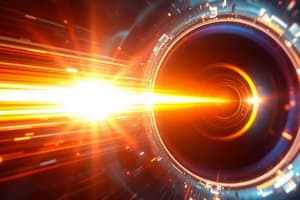Podcast
Questions and Answers
Match the items in the left column to the items in the right column.
Match the items in the left column to the items in the right column.
- Alignment of light in only one vibrational orientation = Polarization
- Mirror that causes parallel incident rays of light to converge at the focus = Concave
- Phenomenon that can be explained only by a particle model for light = Photoelectric effect
- Experiment that showed that diffraction effects could be attributed to light particles = Taylor's experiment
- Principal use of mirrors = Reflection
- Image of the sky seen on a hot road = Mirage
- Type of images always produced by convex mirrors = Virtual
- Pattern produced by light through a narrow slit = Diffraction
- Shape of a converging lens = Convex
- Separating light into component colors = Dispersion
What is the index of refraction of the medium if light traveling through air at $3.00 imes 10^8 ext{ m/s}$ slows down to $2.00 imes 10^8 ext{ m/s}$?
What is the index of refraction of the medium if light traveling through air at $3.00 imes 10^8 ext{ m/s}$ slows down to $2.00 imes 10^8 ext{ m/s}$?
1.50
Click on the smaller picture below to show the correct representation of the three principal rays that locate the image.
Click on the smaller picture below to show the correct representation of the three principal rays that locate the image.
Image Link
What type of image is formed by the lens assuming the object is farther away from the lens than twice the focal length? (Select all that apply)
What type of image is formed by the lens assuming the object is farther away from the lens than twice the focal length? (Select all that apply)
What is the correct location of the image when an object 4 cm tall stands 10 cm in front of a converging mirror of focal length 5 cm?
What is the correct location of the image when an object 4 cm tall stands 10 cm in front of a converging mirror of focal length 5 cm?
What type of image is formed by the mirror when an object 4 cm tall stands 10 cm in front of a converging mirror with a focal length of 5 cm? (Select all that apply)
What type of image is formed by the mirror when an object 4 cm tall stands 10 cm in front of a converging mirror with a focal length of 5 cm? (Select all that apply)
Calculate the index of refraction if the sine of the incident angle is 0.217 and the sine of the refracted angle is 0.173.
Calculate the index of refraction if the sine of the incident angle is 0.217 and the sine of the refracted angle is 0.173.
Choose the answer that explains the photoelectric effect.
Choose the answer that explains the photoelectric effect.
What did Taylor's experiment show?
What did Taylor's experiment show?
Under what circumstances will light display total internal reflection?
Under what circumstances will light display total internal reflection?
Flashcards are hidden until you start studying
Study Notes
Light and Optics Concepts
- Polarization: Alignment of light waves in a single vibrational direction.
- Concave Mirror: A mirror that converges parallel light rays at a focal point.
- Photoelectric Effect: A phenomenon that can only be explained by light's particle model, where light causes electron emission from metal.
- Taylor's Experiment: Demonstrated that individual photons exhibit wave-like characteristics.
- Reflection: The primary use of mirrors, involving the bouncing back of light.
- Virtual Images: Images produced by convex mirrors, which cannot be projected on a surface.
- Mirage: An optical illusion where the sky appears reflected on a hot surface, caused by temperature gradients in air.
- Diffraction: A pattern formed by light passing through a narrow opening.
- Dispersion: The process of separating light into its component colors.
Refraction and Index of Refraction
- Index of Refraction Calculation: If light slows from 3.00 x 10^8 m/s in air to 2.00 x 10^8 m/s in another medium, the index of refraction can be calculated as n = 1.50.
- Sine Values of Angles: Given that the sine of the incident angle is 0.217 and the sine of the refracted angle is 0.173, the index of refraction is found to be n = 1.25.
Image Formation with Lenses and Mirrors
- Image Characteristics: For an object located beyond twice the focal length of a converging lens, the image produced will be:
- Inverted
- Real
- Diminished
- Converging Mirror: An object 4 cm tall placed 10 cm from a converging mirror with a focal length of 5 cm produces:
- A real image
- An inverted image
- An image of the same size as the object
Total Internal Reflection
- Conditions for Total Internal Reflection: Occurs when light travels from a low-velocity medium to a high-velocity medium at an incident angle greater than the critical angle.
Studying That Suits You
Use AI to generate personalized quizzes and flashcards to suit your learning preferences.




